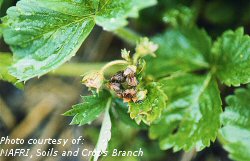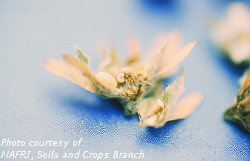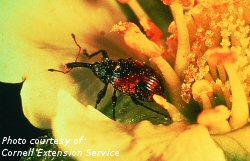Strawberry Clipper Weevils

Clipper weevil damage to strawberry buds

Clipper weevil larva in strawberry flower

Clipper weevil adult
Host Plants And Distribution
The clipper weevil is found throughout North America and feeds on strawberry, raspberry, blueberry, wild brambles and dewberry.
Biology
Adult clipper weevils are small (2-3 mm), dark reddish brown beetles with an elongated snout. Adults overwinter in fencerows and shelterbelts near strawberry plantings. They emerge in early spring when temperatures reach about 16o C and immediately feed upon whatever food plant is available by puncturing a hole in the flower bud with their snout. It is in these holes in strawberry buds that the females later lay their eggs. The weevil then moves down the stem a short distance and cuts or clips the stem, causing the bud to wilt and fall over. The larvae complete their development within the bud, taking 3-4 weeks. The adults that form from these larvae feed briefly then overwinter. There is one generation per year in Manitoba.
Symptoms And Damage
Clipped buds are readily apparent upon visual inspection of plants. See below for important developments in the economic threshold level.
Scouting Techniques
Visual inspection is the easiest way to scout for this pest. Scout areas close to fencerows, shelterbelts and field margins, as these areas are most likely to suffer clipper damage.
Economic Thresholds
Recently thresholds for clipper damage have fallen under question. Recent research suggests that strawberry plants are able to compensate for clipper damage and that minor clipper damage may actually increase yields. Traditionally, thresholds were in the area of 1.5-2 clipped buds per metre of strawberry row. Recent research indicates that a proper threshold should be 20 clipped buds per metre. The higher threshold takes into account the compensation by the strawberry plant.

